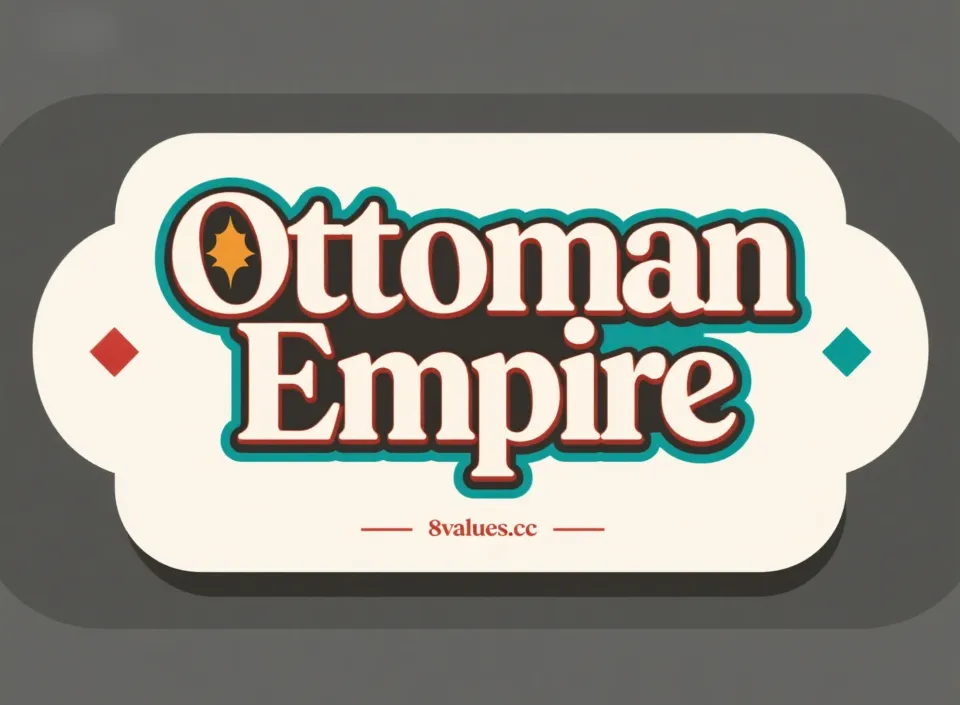Millennium Empire spanning Europe, Asia and Africa: The rise and fall of the Ottoman Empire and the cultural heritage
Deeply interpret the history, politics, military and culture of the Ottoman Empire, and explore its entire process from the Turkic tribe to the rise of world power, as well as its decline and disintegration in the wave of modernization. Learn how this empire spanning three continents of Europe, Asia and Africa has shaped the modern world and explore internal governance and external challenges that affect their destiny. To learn more about the impact of historical and political thoughts on the fate of the country, we welcome the 8Values political values inclination test.
The Ottoman Empire is a multi-ethnic empire established by the Turks, named after its founding monarch Osman I. The empire existed from about 1299 to 1923 and lasted for more than six centuries. It was originally a principality founded by Turkic tribe leader Ottoman I in northwestern Anatolia. At its heyday, the Ottoman Empire's territory spanned southeastern Europe, West Asia and North Africa, controlling vast lands on three continents.
Historically, the Ottoman Empire was also known as the "Turkish Empire". It occupies the intersection of East and West civilizations and has mastered the main land trade transportation lines between Eurasia for six centuries. Since conquering the Mamluk Sultan of Egypt in 1517, he began to serve as the Caliph, the highest religious and political leader in the Islamic world.
The Origin and Early Expansion of the Ottoman Empire
The foundation and rise of the empire (c. 1299–1453)
The Ottoman Empire originated from one of the many Beyliks that split in the Anatolian region after the decline of the Sultanate of Rum. Ottoman I's followers initially included Turkic tribes and Byzantine defectors, many of whom converted to Islam, but not all. Osman I expanded his territory by conquering Byzantine towns along the Sakaria River.
The successors of Ottoman I transformed this small kingdom into a transcontinental empire. His son Orhan occupied Bursa in 1326 and designated it as the new capital. Subsequently, the Ottoman forces entered Europe in the late Middle Ages and expanded through the Balkans. The Battle of Kosovo in 1389 marked the essential end of Serbia's power in the region. Although the Battle of Nicopolis in 1396 failed to stop the Ottoman advancement, in 1402, Timur defeated the Ottoman army and captured Sultan Bayezid I, which put the empire into a civil war, the Interregnum, temporarily alleviated the pressure from Byzantines. The empire's power was not restored until Mehmed I appeared.
Expansion and Extreme: The Golden Age of Suleiman the Great
The Ottoman Empire entered its period of expansion in the 15th and 16th centuries. In 1453, Mehmed the Conqueror captured Constantinople and ended the Byzantine Empire . Constantinople (later renamed Istanbul/Istanbul) became the new capital of the empire. Mohammed II allowed the Orthodox Church to maintain autonomy and land while accepting Ottoman rule.
Selim I and the Caliphate
Selim I (1512–1520) greatly expanded the eastern and southern borders of the empire by defeating Shah Ismail of the Safavid Iran at the Battle of Chaldiran. In 1517, he defeated and annexed the Mamluk Sultanate of Egypt, establishing the Ottoman naval presence in the Red Sea. Selim I then won the title of Caliph, and the Ottoman Empire Sultan became the political and political leader of the universal Muslim world.
Suleiman I and Global Power (1520–1566)
During the reign of Suleiman the Magnificent (1520–1566), the Ottoman Empire reached its peak. He was called "Kanuni" (Kanuni, the legislator) for his many legal reforms.
- European Front: In 1521, Suleiman conquered Belgrade. The first Battle of Mohács in 1526 achieved a historic victory, establishing the Ottoman rule in Central Europe and the present-day Hungary. He besieged Vienna in 1529 but failed to capture it. Transylvania, Wallachia and Moldova became vassal states of the empire.
- Asia and at the sea: In 1535, the Ottomans seized Baghdad from the Persians. In the naval aspect, the empire became the dominant maritime force in the Mediterranean . Admiral Barbarossa Hayreddin Pasha defeated Charles V's Holy Alliance in 1538 in the Battle of Preveza. The Ottoman Empire even sent troops to aid its vassal in Southeast Asia, the Sultanate of Aceh.
At the end of Suleiman's reign, the empire's territory spanned three continents, covering an area of approximately 2,273,720 square kilometers (877,888 square miles).
Challenges of Stagnation, Reform and Modernization
Although some historians have believed that the empire entered a period of decline after Suleiman I's death, modern academic consensus holds that the empire remained economically, socially and militarily resilient and powerful until the mid-18th century, a period that was seen more as "crisis and adaptation."
Military setbacks and power struggles
In the second half of the 16th century, the Ottoman Empire was under pressure due to rapid rise in inflation and war costs. Western European countries have opened up new maritime trade routes (such as the Cape of Good Hope) and bypassed the Ottoman trade monopoly.
Military, the Ottoman Empire experienced major setbacks:
- In the Battle of Lepanto in 1571, the Holy Alliance defeated the Ottoman fleet, which dealt a symbolic blow to the unbeaten image of the Empire.
- In 1683, the army led by Kara Mustafa Pasha was defeated by a coalition forces headed by the Polish king John III Sobieski in the Second Siege of Vienna.
- The Treaty of Karlowitz, signed in 1699, gave the Ottoman Empire a large amount of European territory for the first time, marking the stagnation of imperial expansion.
From the mid-16th to the 17th century, the empire experienced the Sultanate of Women, and young sultan mothers (such as Kösem Sultan) exercised power on behalf of their sons, exerting a huge influence on politics.
Trying to modernize and intervention of the great powers
Faced with external military pressure, especially from the threat from the expanding Russian Empire, the Ottoman Empire began to carry out modernization reforms.
- Military Reform: Sultan Selim III tried to modernize the military in the European way for the first time, but was obstructed by religious conservative forces and the Janissaries and was eventually deposed. His successor, Mahmud II, passed a bloody crackdown on and abolished the Jenicheri Legion in 1826, clearing obstacles for subsequent reforms.
- Tanzimat period (1839–1876): This series of constitutional reforms include the establishment of a modern conscription army, reforming the banking system, replacing religious laws with secular laws, and establishing the postal ministry. The Hatt-ı Hümayun Act of 1856 guaranteed the equal status of all citizens, regardless of race or belief.
- Constitutional attempt: The pinnacle of Tanzmatt's reform was the Kanûn-u Esâsî promulgated in 1876, which established the First Constitutional Era and introduced the parliamentary system. However, Sultan Abdul Hamid II quickly suspended parliament.
During this period, the empire began to borrow a large amount of foreign debt due to high war burdens and infrastructure construction, and eventually declared bankruptcy in 1875. In 1881, the Ottoman Public Debt Administration was established, controlled by European countries and had a significant impact on the imperial economy.
The wave of nationalism and the decline of the empire
With the rise of nationalism, the Ottoman Empire began to lose a large amount of European territory in the 19th century. Vastual states such as Greece (1829), Serbia, Romania and Montenegro gained complete independence after the Russian-Turkish War (1877–1878). By the early 20th century, the empire's provinces in North Africa, including Algeria (occupied by France in 1830), Tunisia (occupied by France in 1881) and Libya (occupied by Italy in 1912).
Young Turkish Revolution
In 1908, the Young Turks movement broke out, restored the Constitution and started the Second Constitutional Era , hoping to save the empire through liberalization and modernization. However, during the subsequent Balkan Wars (1912–1913), the empire lost nearly all of its European territory. After the defeat, the Committee of Union and Progress (CUP) became increasingly radical and nationalist, and in 1913 established a de facto dictatorship.
World War I and the End of Empire
In 1914, the Ottoman Empire joined the Allies and was involved in World War I. Despite successful defenses in the Battle of Gallipoli in the Dardanelles, internal dissent, especially the outbreak of the Arab Revolt (1916–1918), reversed the war in the Middle East.
During this period, the empire committed Genocides on the Armenians, Assyrians and Greeks minorities within their territory. Among them, the Armenian Genocide caused about 600,000 to 1.5 million Armenian deaths, a tragedy that occurred under the government's expulsion and ethnic cleansing policies.
After the defeat in 1918, the Allies occupied and divided the empires under the Treaty of Sèvres in 1920. The Turkish War of Independence, led by Mustafa Kemal Atatürk, then won.
On November 1, 1922, the Sudan system was abolished. On October 29, 1923, the Republic of Turkey was established in Ankara, replacing the Ottoman state. On March 3, 1924, the Caliphate system was also abolished, and the Ottoman Empire was completely destroyed.
8Values Political Ideological Testing and Historical Political Analysis
In the long history of the Ottoman Empire, its political system has undergone drastic changes in absolute monarchy, theocratic politics and a brief attempt at constitutional monarchy. Especially the debate on centralization, religious power and civil rights triggered by the Tanzmatt period and the young Turkish revolution reflects the fierce conflict between political values such as "centralization" and "freedom", and "tradition" and "progress". If readers are interested in their own political values, they can try to test their political values tendency and explore more analysis of historical issues. Please follow our official blog .
The political and legal system of the Ottoman Empire
Political system and power structure
Before the reforms in the 19th and 20th centuries, the Ottoman Empire's state organization mainly consisted of two dimensions: military administration and civil administration.
- Sultan: Located at the highest position of the system of power, regarded as the embodiment of the government, with absolute monarchy (except for the brief constitutional periods of 1876 and 1908).
- Caliph: Since Selim I, the Ottoman Sultan has also served as the title of Caliph and has become the spiritual leader of the Islamic world.
- Central Government: A meeting of advisors known as Divan or Porte. Grand Vizier (Prime Minister) was appointed by the Sultan and had huge executive power. After the Sultan stopped participating in government affairs in the late 16th century, Grand Vizier actually became the head of state.
- Empire Harem: Valide Sultan was the most important power figure in the Empire Harem. She even held the power of the state during the "Sultan Feminist Period" (1533–1656).
Legal system and Millet system
The Ottoman Empire's legal system was diverse, which allowed the coexistence of religious laws (Sharia, Sharia) and dynasty laws (Qanun, Caron regulations). Shariya is the main court system in Islam, but non-Muslim groups also have their own courts, and there are trade courts that deal with trade disputes.
The Millit system is a socio-political structure unique to the Ottoman Empire. It grants a high degree of autonomy to non-Muslim religious communities such as the Greek Orthodox Rumilit, Jewish community and the Armenian Church. Non-Muslim subjects (dhimmi) are protected but are subject to higher taxes than Muslims, especially jizya .
military force
The Ottoman army was once one of the most advanced combat forces in the world, taking the lead in using muskets and cannons.
- Janissaries: The main infantry unit of the empire, recruited boys from Christian families through the Devşirme system and converted to Islam, received Enderûn education and military training.
- Sipahi: Cavalry units, relying on high speed and mobility, mimicking the tactics of the Mongol Empire.
- Modernization: In the 19th century, the modernization of the Ottoman military began with the abolition of the Jenicer Legion. The Turkish Navy made a huge contribution to expansion in the 16th century, once had a size second only to the British and French fleets, but declined due to economic collapse and Sudan’s distrust. The Ottoman Aviation Squadrons was established between 1909 and 1911 and is one of the earliest flight combat organizations in the world.
Unique Ottoman Society and Culture
The Ottoman culture was diverse, absorbing traditions, arts and institutions from Persia, Byzantine, Arabic, and other conquered areas and developing a unique Ottoman cultural identity.
Language and demographic
Ottoman Turkish is the official language, an Augustus Turkic language that is highly influenced by Persian and Arabic. In the late empire, French became a common Western language among the educated elite.
The multinational nature of the Ottoman Empire is reflected in its population structure. By 1914, the non-Muslim population (mainly composed of Greeks, Armenians and Jews) still accounted for nearly one-fifth of the imperial population. During the 19th century empire contraction, between 7 million and 9 million Muhacir refugees, including Crimean Tatars, Cherks and Bosnians, migrated from the lost Balkans, Crimea and Caucasus to Anatolia and Eastern Thrace, greatly changing Turkey's population composition.
Religion and Cultural Life
In terms of religion , Sunni Islam is the state religion, and Hanafi is the official school of jurisprudence. Sufism is also very popular in the Ottoman region. The Empire provided limited religious freedom and protection to Christians and Jews (i.e., “The Scholars”).
Architecturally , Ottoman architecture combines elements of Seljuk Turkish, Byzantine and Iranian architecture. Mimar Sinan was the most important architect of the classical period, and his works such as the Süleymaniye Mosque are representatives of the Ottoman style. During the Tulip Period of the 18th century, Ottoman architecture began to be influenced by the Western European Baroque style.
Literature and art include highly stylized Divan poetry , nonfiction prose , and the miniature traditions influenced by Persian and Byzantine. Ottoman classical music combines elements of Byzantine, Arabic and Persian music and is part of elite education.
Conclusion: The historical heritage of the Ottoman Empire
The Ottoman Empire rose from a border marquis in Anatolia to a global power that spans the three continents of Europe, Asia and Africa, and integrates Eastern and Western civilizations politically and culturally. It controlled a large area of the Mediterranean and became the only Islamic force in the early modern era that could rival the rising European Christian state.
Although the empire eventually disintegrated under a variety of factors such as waves of nationalism, lag in military technology and failure to successfully respond to modernization challenges, the administrative system, legal system (especially the Milit system), and its unique art, architecture and cuisine (Ottoman cuisine) profoundly influenced dozens of modern countries, including Turkey, from the Balkans to the Middle East and North Africa. The history of the Ottoman Empire is a complex case of multicultural governance, religious tolerance and conflict under the rule of empire in world history, and the struggle of traditional power structures in the process of modernization.






